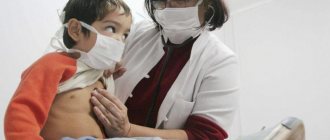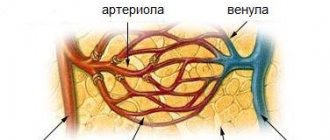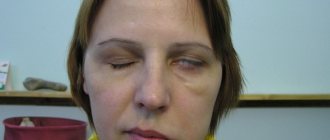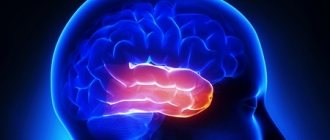Meningococcal infection is one of the most severe among acute infectious diseases of the body. Clinically, such a pathology can manifest itself in different ways, but in any case it will be quite dangerous.
The danger lies in the very rapid, literally lightning-fast development of the disease, which can provoke death or serious complications. Today we’ll talk in more detail about the essence of meningococcal infection, its manifestations and characteristics. Interesting? Then be sure to read the material below to the end.
Characteristics of the pathological syndrome
Severe pathology accompanied by an inflammatory process of the bases of the spinal cord and/or brain. There are several types of fabrics: hard and soft. Depending on the location of the lesion, the following types of diseases are distinguished:
- Leptomeningitis - occurs most often, with this form of the disease soft tissues are injured,
- pachymeningitis – damage to the hard membranes of the “gray matter”, diagnosed in 2% of 100 patients,
- Panmeningitis is an inflammation of all brain tissues.
In medicine, when diagnosing meningitis of various forms of an infectious disease, it is understood that only the soft membranes of the “gray matter” are affected. This is one of the most serious pathologies that provokes the development of complications, impaired mental development, and permanent disability.
Complications
Complications of meningococcal meningitis are as follows:
- cerebral edema, up to coma;
- toxic shock, which is manifested by the failure of the body systems - kidneys, liver, lungs, heart, the presence of abnormalities in the functioning of at least one of their systems requires resuscitation measures;
Less dangerous complications that are not life-threatening and develop with a favorable prognosis include:
- visual and hearing impairments;
- paresis and paralysis;
- cognitive impairment;
- disability.
Forms of infectious disease
Before the creation of antibiotics, the risk of death reached 95%. The use of penicillin drugs has reduced the mortality rate.
In modern medicine, synthetic medications are used to treat meningococcus; to prevent many forms of the disease, special vaccines are used against the most common pathogens - Haemophilus influenzae, meningococcus and pneumococcus.
The infectious form of the disease includes:
- Meningococcal meningitis. Diagnosed in children, adolescents and young adults. Meningococcal infection is transmitted from carriers of the bacilli or patients.
- Hemophilic type of disease. This form of meningitis most often occurs in infants and children under 5 years of age. In adults, we are talking about a secondary type of infection during the inflammatory process of the sinuses and middle ear.
- Pneumococcal meningitis. It develops as a secondary infection during another type of inflammation. It is diagnosed regardless of age, but the majority of patients are people over 50 years old and infants.
Meningitis as an infectious form of pathology is quite rare, only in isolated situations or during outbreaks recorded every 10-25 years.
Symptoms
The incubation period for meningitis ranges from 2 to 12 days. 2-3 days after infection, acute nasopharyngitis appears, accompanied by high fever. If bacteria enter the bloodstream, the patient experiences severe chills and headache.
Signs of the disease appear differently. Some symptoms of the disease may be absent altogether. In children under one year of age, signs of meningitis develop very quickly. They observe:
- elevated temperature;
- cold extremities;
- moodiness;
- pale skin;
- nausea;
- aching in the limbs;
- tension or bulging of the fontanel;
- rash, as in sepsis.
On this topic
- Meningitis
What are the dangers of bacterial meningitis?
- Ekaterina Nikolaevna Kislitsyna
- March 26, 2020
Septic spots do not occur when a child is infected with group B streptococci or Haemophilus influenzae. With these types of diseases, there is a fear of bright light, rapid heartbeat and breathing problems.
Adults should sound the alarm when three main signs of an infectious disease appear:
- pain in the arms and legs;
- pale skin;
- coldness of the extremities.
They occur before other manifestations of the disease - photophobia and stiff neck. Seeing a doctor at the first symptoms of the disease will save the patient’s life and avoid dangerous complications.
The clinical picture of the pathology also includes:
- fever;
- severe unbearable headaches;
- constant vomiting;
- pain in the cervical region.
The pain syndrome intensifies with tension in the neck muscles. In children under one year of age, it is difficult to determine the disease based on the above symptoms, since they cannot report their condition. In this case, parents should be wary of the child's pale appearance, lethargy and capriciousness.
The infectious rash associated with meningitis appears as bright purple spots. In appearance they are similar to bruises. The appearance of spots on the skin indicates a serious pathology that requires immediate treatment.
Routes of transmission of meningococcal bacillus
Primary damage to the bases of the brain as an infectious disease develops under the influence of pathogenic bacteria. Microorganisms and viruses that cause meningitis are transmitted in different ways:
- by airborne droplets: the pathogen is released with mucus when sneezing and coughing, saliva,
- contact method: in direct interaction with a patient or a carrier of the virus, the use of common household items, hygiene products, towels, dishes,
- by the fecal-oral route if personal hygiene is not observed: eating with dirty hands, consuming unprocessed fruits and vegetables,
- hematogenously: the causative agent of the disease of various origins is transferred through the blood plasma, then the infection spreads throughout the body to the membranes of the “gray matter”,
- lymphogenous route: the infection spreads to all organs through the lymph,
- placental: with the intrauterine formation and passage of a “provocateur” of the inflammatory process through the placenta, as well as infection in the tract during labor or penetration of an agent from the amniotic substance to the fetus,
- orally: when swallowing water infected with meningococcal bacillus (while swimming in pools, reservoirs, drinking unboiled liquid).
Origin of infectious pathology
In addition to meningococcus, the causative agent of meningitis can be pneumococcus or tuberculosis bacillus. Often, the infection spreads to the membranes of the human brain due to inadequate treatment of certain pathologies:
- Sinusitis.
- Rubella.
- Pigs.
- Osteomyelitis of bones.
- Otitis.
Among adult patients, men aged 20-30 years are susceptible to the disease. A common cause of inflammation at the base of the “gray matter” at this age is neglect of one’s health.
Representatives of the fairer sex are less susceptible to meningococcal infection, but during pregnancy the danger of the pathological process increases due to the weakening of the body's defenses. The best prevention of the disease is timely sanitation, vaccination, treatment of diseases of inflammatory origin, and limiting contacts.
Signs of an infectious disease
After contact with a carrier of meningococcal bacillus and possible infection, the symptoms of the inflammatory process make themselves felt only after some time. The incubation period of the disease may vary in duration, depending on the age category and general health, but generally it lasts 1-7 days.
Meningococcal viral meningitis and its symptoms manifest themselves as follows:
- migraine attacks,
- meningitis is accompanied by high temperature up to 40 degrees, chills, fever,
- increased sensitivity to irritating factors: tactile, sound, light,
- hallucinations, confusion, dizziness, even coma,
- loss of appetite, severe vomiting, feeling sick,
- meningitis makes itself felt by stool disorder,
- pressure on the eyes, conjunctivitis, lacrimation,
- soreness of the lymph nodes,
- unpleasant sensations in the area of the trigeminal nerve trunk,
- Kernig's symptoms: it is impossible to straighten the lower limbs at the knees,
- a positive reaction to Brudzinski’s sign: unconscious movement of the arms and legs when pressing, tilting the head,
- meningitis is manifested by Pulatov's symptoms: unpleasant discomfort when tapping on the head,
- Mendelian sign: when pressed behind the auricle, painful sensations occur.
Establishing diagnosis
The diagnosis is made based on the clinical data obtained.
There are some clinical signs that are considered the most important. For example, an acute course of the disease, obvious symptoms and fever, a sharp decrease in appetite, poor sleep, discomfort under the eyelids, weakness throughout the body, excessive excitement or chills.
Meningeal syndrome may also occur, characterized by severe pain in the head, nausea, and muscle stiffness in the back of the head.
Diagnostic methods and course of therapy
The initial examination of the patient is to identify clinical signs of meningitis and the presence of certain rashes. For a correct diagnosis, which will make it possible to establish the presence of a certain type of pathogen, it is necessary to take a test for bacteria, puncture the cerebrospinal fluid, and study the nasopharyngeal mucosa.
Meningococcal viral meningitis, treatment of which is carried out only in a hospital setting, requires special attention from doctors. The sooner a patient sees a doctor, the greater his chances of recovery and the absence of possible problems in the future. Methods and duration of therapy depend on the form, severity of the pathology, as well as the presence of concomitant diseases.
Treatment of meningitis consists of the following principles:
- the patient is prescribed antibiotics - intravenous and intramuscular,
- detoxification treatment of meningitis is carried out,
- vital functions of the body are supported with the help of B vitamins, ascorbic acid, cocarboxylase,
- it is possible to use plasma expanders, glucocorticoids,
- to prevent cerebral edema during meningitis, diuretics are prescribed,
- For medical reasons, medications are prescribed to increase blood pressure and oxygen therapy is provided.
Meningococcemia is a generalized form of infection of meningococcal origin, characterized by bacteremia with massive death of pathogenic microorganisms, manifested by symptoms of advanced septicemia with thrombohemorrhagic syndrome and toxic shock. This type of disease requires special and long-term treatment, just like meningococcemia.
Etiological treatment
It is used to eliminate generalized forms of the disease, and most often it is formed on antibiotics, mainly based on benzylpenicillin salts. These can be either natural or semi-synthetic products. Ampicillin and Oxacillin, as well as Levomycetin, are no less effective. The daily dose is based on the patient's weight. Usually 5-9 days are enough for the therapy to give a positive result.
After a series of clinical trials, it was found that antibiotics from the tetracycline group cope well with meningococcal bacteria. For mild forms of the disease, long-acting sulfonamides can be used.
Auxiliary therapies
In combination with drugs that are active against “provocateurs” of pathology, symptomatic drugs are prescribed. These include:
- Anti-swelling medications for meningitis: Mannitol, Furosemide.
- Anticonvulsants: Phenobarbital, Relanium, Seduxen.
- Detoxification methods for treating meningitis: infusions of electrolytes, crystalloids, colloids.
- Nootropics.
Depending on the development of the pathological process or emerging complications, treatment of meningococcal meningitis may include correction of concomitant diseases: cardiovascular, adrenal, and respiratory failure.
Pathogenetic treatment
The basis of this therapy is the fight against poisoning of the body, for this they use:
- Glucose solution, Ringer's, polyvinyl alcohol, polyvinylpyrrolidone, dextran, plasma and albumin.
- Diuretics to eliminate brain swelling. Usually this is Furosemide, Lasix.
- Vitamin complexes consisting of vitamins C, B1, B2, B6, glutamic acid and cocarboxylase.
- In severe forms of the disease, glucocorticosteroid hormones are used.
- Oxygen therapy.
- Ultraviolet irradiation of blood.
- If renal failure occurs, which leads to toxemia and shock, hemodialysis is performed.
What can a patient expect after illness?
Meningitis is a dangerous pathology, both in the process of infection of the membranes of the “gray matter” and the possible consequences.
Complications of an infectious disease include:
- hearing problems,
- epilepsy attacks,
- endocarditis,
- purulent arthritis,
- poor blood plasma clotting,
- mental retardation,
- mood swings, excessive excitability,
- If infected in infancy, hydrocephalus may develop.
The life of the patient depends on timely treatment of meningitis. At the first symptoms, you need to urgently visit a doctor or call an ambulance team. If signs of pathology appear in a baby, diagnosis should be made as quickly as possible - with the rapid progression of the disease in children, minutes count, and this will determine whether therapy will help or not.
How to prevent inflammation
There are no reliable ways to help protect your baby from the disease. An effective vaccine against meningitis has not yet been created. At the first symptoms of pathology, it is better to immediately consult a doctor rather than self-medicate.
Nonspecific methods of protection against meningitis:
- Limit your child’s contact with a potential carrier of the virus.
- During an epidemic, it is better to wear a medical bandage when in public institutions or municipal transport.
- Wash your child's hands thoroughly after going outside.
- You should not visit cities where there is an outbreak of the epidemic.
- Avoid swimming in open water.
By following these simple tips, you can reduce the likelihood of infection. But do not forget that the incubation period for meningitis depends on the type of pathogen and can last from ½ day to 35 days. At the first alarming signs of an inflammatory process, it is better to immediately visit a doctor.
Prognosis for a patient after suffering a pathology
With quick, correct diagnosis of the disease and effective therapy, meningococcal meningitis cannot cause harm to most vital systems and organs - there will be no irreversible consequences in this situation. But in some cases, the patient loses visual functions and hearing, and he may be bedridden for a while.
A large number of deaths due to inflammation of the membranes of the “gray matter” are observed only with the rapid progression of meningococcemia. In other cases, irreversible effects occur in only 1% of patients, but sometimes epilepsy or hydrocephalus may develop.
If a child has suffered from an infectious pathology, he is constantly monitored by doctors, he is undergoing medical examination for some time - 2 years. With inadequate therapy or incorrect diagnosis of the disease, the patient often experiences a relapse 1-4 weeks after the end of the course of treatment.
You should not try to get rid of meningitis on your own; only timely examination and proper therapy will keep your child healthy and prevent the development of serious consequences.












